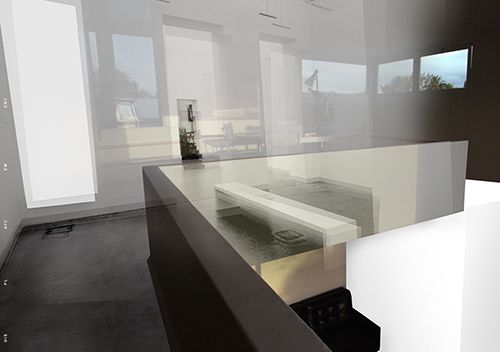DISPLAYCEMENT
The exhibition title – Displaycement – presenting works by Klaus Pamminger and Jonas Feferle in dialogue at the Galerie Raum mit Licht already provides the viewer important hints towards under-standing the artists’ methods: Both the individual works as well as how they are presented follow the rules of a spatial shift in meaning with the source and anchor found in the medium of photography, and in the case of the current exhibition, even ranging to the display of the gallery spaces itself.
An inquiry into a spatial understanding of photography is something that has concerned both artists for some time now and is easily observed in their artwork produced thus far. In Klaus Pamminger’s recent work we encounter photographic spatial constructions with elements inlayed in an intarsia like fashion, the titles of the works bearing witness to its method. In his Rauminvasionen (or Space Invasions), he went yet a step further overlaying photographic space with film stills, thus recon-structing the given space – a process that Pamminger also uses in his work with the medium of film, transferring it to yet another dimension.
By contrast, Jonas Feferle inquires into the material presence of photography within physical space, using a common support material for photography – aluminum composite panels – in installations where architecture is clad with the panels and rendered as an image. This act of cladding is marked by a certain ambivalence, as the space is both emphasized and at the same time made to vanish: The space as a whole becomes an image, just as the image panel becomes a conform element of the space. In a final step, Feferle returns to photography as such, photographing the architecture adapted by his installation, then employing a method that resembles something like a negative intarsia removing the portions of the photograph that would otherwise show the clad sections of space: In this democratization of exposed support material in both senses, the layers of meaning become equal in their dimensional difference, referring in the linkage of the two to a meta-level, which is as such inscribed into the oeuvre of both artists in the exhibition Displaycement.
Hence, within the exhibition setting, we encounter on the one hand Feferle’s installations made from aluminum composite panels coated in white, whose relative size and dimension are directly linked on the other hand to the projections of Pamminger’s films that show nothing less than digital masks that he otherwise uses in the process of layering moving and still images: Here too, a reference is made to a level beyond photography, one that was only initially constituted out of space. In the context of the exhibition, the term “setting” (familiar in film) can be understood literally when the works in their self-reflection stand as indexical signs for an expandable horizon of meaning of themselves.
The extent of which the artists work towards such an opening – with the multivalent spatial structures as their basis – is made manifest in the cladding of window and door elements by Feferle as well as in Pamminger’s most recent work Mackey vs. Film, in which he overlays film stills from Gone with the Wind and Mutterliebe – both of the year 1939 – onto the photographic and film images of the Mackey House in Los Angeles – also built in the same year – where the different layers engage in a relationship or even in competition. The result is a condensation of historical content that through the use of formally aesthetic tools firstly points to the temporality of the medium and finally to a superordinate continuum.
Presentation as well as the references between the artworks that were conceptualized together and one to the other may be seen, in their concern with the conditions of space, as also being in alignment with the discourse of the dispositif, especially when the principle of spatial order in favor of its arrangement is itself critically put into question. When Jonas Feferle installs the aluminum composite panels with white coating in the gallery spaces, light is shed on the relevance of the dispositif in its sociological context, letting us also consider the relationship of the white cube to the objects otherwise usually embedded therein. Similarly, Pamminger’s films may also be contextualized, when the temporal sequence of the individual masked spatial elements ultimately likewise close the gap between the projected masks of space and the space within which they are exhibited. The white cube is in this case a temporal realm of experience that can be fathomed with the eyes, just as the gallery space represents a place that is perceived differently from subject to subject, but especially as a place in flux.
The dialogue within the exhibition begins with the artists’ opposing postures in regards to the poles of consolidation and dissolution in space, bringing them eventually to the mutual premise of art as an operation transcending dimensional constraints, and hence towards the elusiveness of images made for each other.
Text: Andreas Müller
